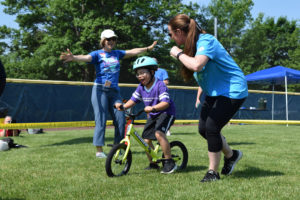
Benefits Of Biking; How Learning To Ride A Bike Is Inspiring Kids With Down Syndrome
 Strider Balance Bikes are used in the All Kids Bike Learn-To-Ride Kindergarten PE program because they are designed to specifically help individuals learn balance and coordination BEFORE pedaling. The bike used is the Strider 14X which starts in “balance mode” (no-pedals) and then quickly with one bolt converts to a pedal bike. The simple, no-pedal design allows children to learn to ride on two wheels, instilling considerable confidence and bike handling skills before pedaling. This method also encourages the development of spatial awareness, balance, and basic motor skills so everyone can reach their maximum riding potential. Not only are these bikes helping children learn how to ride quickly and without training wheels, but other Strider Bikes are also helping adults, seniors and those with learning constraints such as Autism, Down syndrome and others facing balance and coordination disabilities learn the skill of two-wheel bike riding.
Strider Balance Bikes are used in the All Kids Bike Learn-To-Ride Kindergarten PE program because they are designed to specifically help individuals learn balance and coordination BEFORE pedaling. The bike used is the Strider 14X which starts in “balance mode” (no-pedals) and then quickly with one bolt converts to a pedal bike. The simple, no-pedal design allows children to learn to ride on two wheels, instilling considerable confidence and bike handling skills before pedaling. This method also encourages the development of spatial awareness, balance, and basic motor skills so everyone can reach their maximum riding potential. Not only are these bikes helping children learn how to ride quickly and without training wheels, but other Strider Bikes are also helping adults, seniors and those with learning constraints such as Autism, Down syndrome and others facing balance and coordination disabilities learn the skill of two-wheel bike riding.

“Kids with Down syndrome have balance issues that fuel an intense fear of falling. If you can develop training to overcome that fear, learning explodes” Dale Ulrich, professor of movement science at the University of Michigan has stated. After some research of this statement by Dale Ulrich, we found a great study that explored the benefits of children with Down syndrome learning to bike.
The University of Michigan conducted a two-year study of the feasibility and benefits of teaching children with Down syndrome to ride bikes that was published in the October 2011 issue of the Physical Therapy Journal. “Results showed that 56 percent of the 61 study participants in the U-M School of kinesiology Down syndrome bike training study learned to ride a bike”, said Dale Ulrich, professor of movement science and study author. Researchers measured participants’ level of physical activity prior to training, at seven weeks and then one year after learning to ride and found that kids who learned to ride reduced their sedentary behavior by 75 minutes a day. Ulrich says “That’s a lot, it’s unbelievable. We were not expecting this large of a drop in sedentary activity, this means these children are getting involved with other activities. They overcome their fear of falling while riding a bike and as a result become more motivated to try other physical activities.”

The kids who learned saw decreased body fat compared to increased body fat in those who did not learn to ride. The kids who learned to ride also spent more time in moderate to vigorous physical activity. “Though the study focused on kids with Down syndrome, bike riding has big implications for all kids with or without learning constraints, including those with autism”, Ulrich said. “Bike riding helps counteract the higher levels of social isolation and health problems kids with Down syndrome and other disabilities face.”
Just look at the transformation in this video below, of David, a young boy with Down syndrome who was determined to be on two-wheels. With the proper training, he was able to achieve his biking goals and even push on, further expanding his riding passion.
There are many milestones every child should experience over the years, such as learning to tie shoelaces, sing the alphabet, or jump rope. When children learn to ride a bike, time spent in sedentary activity drops and time spent in moderate to vigorous physical activity increases, a sure way to influence the health and functioning of ALL children as a new world full of possibilities opens for them.
 If you are interested in the inclusive Learn-To-Ride program in your community, please contact one of the All Kids Bike staff today.
If you are interested in the inclusive Learn-To-Ride program in your community, please contact one of the All Kids Bike staff today.